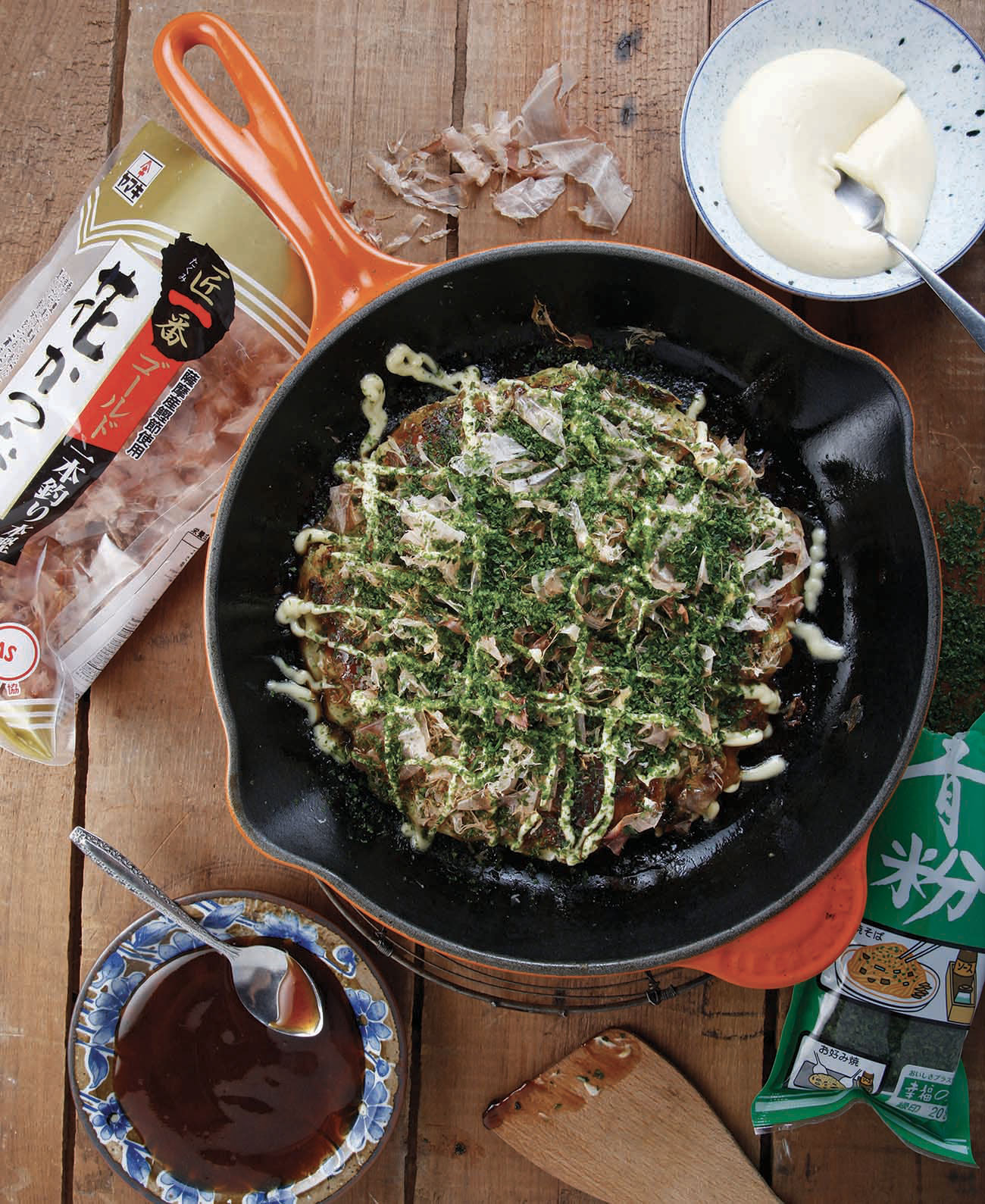Recipe for Osaka-Style Okonomiyaki by Tadashi Ono and Harris Salat
This Japanese omelette can be made with different toppings, but here, the authors have chosen to garnish it with pork belly.

Penguin Random House
Chef Tadashi Ono and culinary journalist Harris Salat share their recipe for okonomiyaki, one of the iconic dishes from the capital of Kansai, Osaka. This sort of crepe/pancake/omelette hybrid is made from a multitude of ingredients (okonomiyaki comes from okonomi ‘as you like’ and yaki ‘grilled’), before being cooked on a hotplate and topped with mayonnaise.
‘We use fresh pork belly, but in Osaka, you can also find okonomiyaki cooked with octopus, squid, prawns, sliced chicken, just veggies, spring onions or kimchi. So feel free to mix and match!’ explains Harris Salat.
Ramen, tempura curry, and gyoza, in Japanese Soul Cooking the two authors offer over 100 recipes for comforting dishes, complemented with new ingredients and techniques. Above all, they have ultra-detailed instructions and photos illustrating each step to make the recipes fool-proof.
Serves 4
Ingredients
450 g flour
250 ml dashi, or water, cold or at room temperature
1 teaspoon salt
1 teaspoon baking powder
2 teaspoons sugar
450 g cabbage, coarsely chopped
4 eggs
60 ml toasted sesame oil
240 g fresh pork belly, thinly sliced
Toppings:
Okonomiyaki sauce
Kewpie mayonnaise or other mayonnaise
Aonori (powdered nori seaweed)
Dried, shaved bonito (katsuobushi)
Method
To make the batter, mix together the flour, dashi, salt, baking powder, and sugar in a large bowl. Add the cabbage to the batter and mix well for at least 30 seconds, until all the cabbage is coated. Add the eggs and mix, lightly this time, for about 15 seconds, or until the eggs are just combined with the cabbage.
Preheat a nonstick or cast-iron skillet for at least five minutes on medium-low heat. Add 1 tablespoon of the sesame oil, making sure to coat the entire surface of the skillet. Cook the okonomiyaki in batches. Spoon the cabbage and batter mixture into the skillet to form a pancake about 6 inches in diameter and about 1 inch thick. Don’t push down on the cabbage; you want a fluffy pancake. Gently lay about one quarter of the pork belly slices on top of the pancake, trying not to overlap.
Cook the pancake for about three minutes. Use a long spatula (a fish spatula is ideal) to carefully flip the pancake, so the side with the pork belly is now facing down. Gently press down on the pancake with the spatula (don’t push too hard, you don’t want batter spilling from the sides). Cook for about five more minutes, then flip the pancake again, so the side with the pork belly is now facing up (if the okonomiyaki comes apart when you flip it, don’t worry; use a spatula to tuck any stray ingredients back into the pancake). Cook for about two more minutes. When it’s ready, the pancake should be lightly browned on both sides, the pork cooked through, and the cabbage inside tender.
Transfer the pancake to a plate, pork-side up, and add the toppings. Squeeze about 1 tablespoon of okonomiyaki sauce onto the pancake, in long ribbons. Then squeeze on about 1 tablespoon of mayonnaise, also in long ribbons. Next, sprinkle about 1 tablespoon of aonori over the pancake, followed by about 1 tablespoon of dried, shaved bonito (add more or less of any topping, to taste).
Cut the pancake into quarters and serve immediately.
Repeat with the remaining 3 tablespoons oil and pancake batter.
Variation: Substitute 8 ounces ground pork for the pork belly. Add the pork to the batter after adding the cabbage and mix well. Then add the egg and mix lightly to prepare the batter.
Japanese Soul Cooking (2013), by Tadashi Ono and Harris Salat, is published by Penguin Random House (available in English only).
Harris Salat and Tadashi Ono have also written other cookbooks together, such as Japanese Hot Pots and The Japanese Grill.

Penguin Random House
TRENDING
-
The Tattoos that Marked the Criminals of the Edo Period
Traditional tattoos were strong signifiers; murderers had head tattoos, while theft might result in an arm tattoo.

-
Paris, Tokyo: Robert Compagnon
With his co-chef and talented wife, Jessica Yang, Robert Compagnon opened one of the top new restaurants in Paris: Le Rigmarole.
 3:31
3:31 -
Chiharu Shiota, Red Threads of the Soul
Last year, more than 660,000 people visited the retrospective 'Chiharu Shiota: The Soul Trembles' exhibit at the Mori Art Museum.

-
‘Before Doubting Others, Doubt Yourself. Who Can Truly Say a Dish Isn’t What It Used to Be?’
In ‘A Non-Conformist’s Guide to Surviving Society’, author Satoshi Ogawa shares his strategies for navigating everyday life.

-
The Story of Sada Yacco, the Geisha who Bewitched Europe
Described by Dazed magazine as the first beauty influencer, she has been restored to her former glory since 2019.





